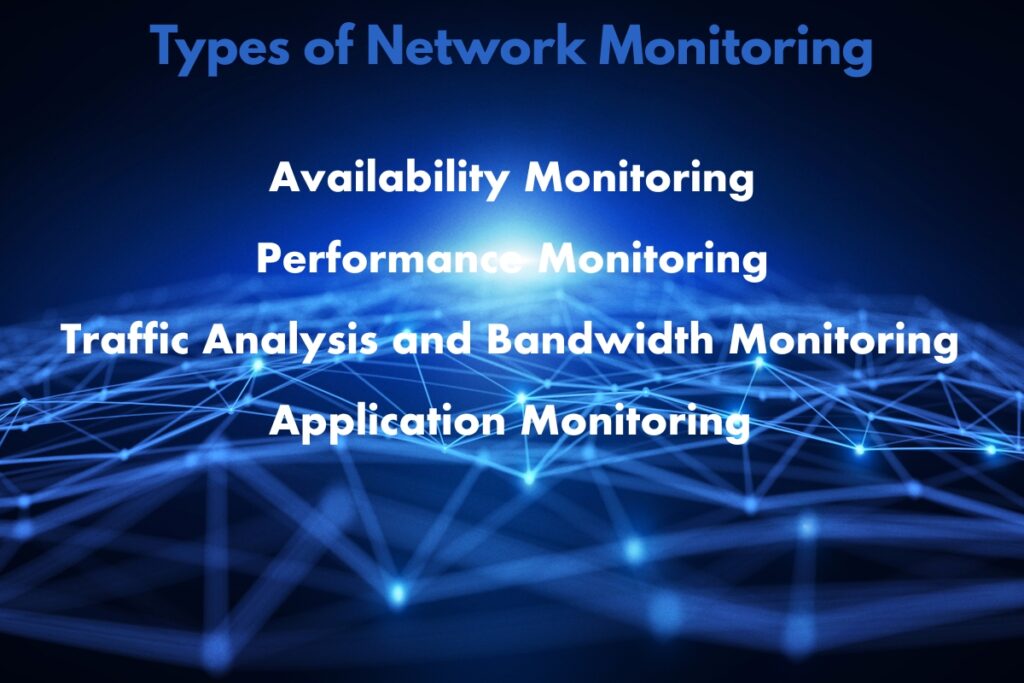Ever had that moment when your entire office suddenly can’t access email, your cloud applications stop responding, or your phones go down?
That sinking feeling in your stomach is the realization that your network just failed – and it’s costing your business money every minute it stays down. For law firms, healthcare practices, and professional services, even brief connectivity issues can mean missed client communications, inaccessible case files, or an inability to access critical systems.
So how do smart businesses prevent these costly disruptions?
The answer is network availability monitoring – a proactive approach that catches problems before they cause downtime. Let’s explore what this means for your business and why it matters more than you might think.
What Is Network Availability Monitoring?
Network availability monitoring is the continuous, automated process of tracking your network infrastructure to ensure everything stays operational and accessible. This includes monitoring servers, routers, switches, firewalls, internet connections, and critical applications. Unlike reactive IT support that scrambles to fix problems after they’ve already caused disruption, proper monitoring systems constantly check status, measure performance, and detect unusual behavior.
When issues emerge, alerts are triggered immediately – often before users even notice a problem. Effective monitoring tracks both basic availability (is the system up or down) and performance metrics (is it responding quickly and efficiently).
This gives IT teams a comprehensive view of network health and enables them to address small issues before they become major outages. The various types of network monitoring work together to create a complete picture of your infrastructure’s health.
Why Network Availability Monitoring Is Critical for Business
The business impact of network downtime is substantial and immediate:
- Direct Financial Costs – Downtime costs average $5,600 per minute according to Gartner research. For small businesses, even $300-500 per hour in lost productivity can be significant.
- Operational Disruption – Modern businesses depend entirely on network connectivity for everything from email to applications, VoIP phones, and customer interactions.
- Reputation Damage – Clients and customers form impressions quickly when your systems aren’t available when needed. For professional services, this directly impacts client confidence.
- Data Security Risks – Unmonitored networks are more vulnerable to security breaches, as intrusions often begin with network anomalies that proper monitoring would detect.
For regulated industries, the stakes are even higher.
According to the Information Technology Intelligence Consulting Research, 98% of organizations say a single hour of downtime costs over $100,000. Continuous monitoring prevents these costs by identifying and resolving issues before they escalate.
Types of Network Monitoring

Comprehensive network availability monitoring involves several distinct but complementary approaches:
Availability Monitoring
This fundamental type checks if network devices, servers, and services are operational and accessible. It typically uses ping tests, service checks, and uptime tracking to provide basic up/down status, alerting immediately when systems fail or become unreachable.
Performance Monitoring
Beyond simple availability, performance monitoring tracks response times, bandwidth utilization, latency, packet loss, and other metrics, ensuring the network operates efficiently. This identifies slowdowns before they become complete outages and affect users.
Traffic Analysis and Bandwidth Monitoring
This monitoring type examines network traffic patterns, bandwidth consumption, and data flows to identify bottlenecks, unusual activity, or capacity issues before they cause problems. It helps with capacity planning and detecting abnormal network behavior that might indicate security concerns.
Application Monitoring
Focused on business-critical software, application monitoring ensures specific programs remain responsive and functional. This goes beyond basic connectivity to track application-specific metrics like database response times, web server performance, and user experience measurements. Understanding these different types of network monitoring tools helps businesses implement comprehensive coverage rather than partial visibility that misses critical issues.
Essential Network Monitoring Tools and Technologies
Effective monitoring requires several key technologies working together:
| Tool Type | Function | Business Benefit |
| Network Monitoring Platforms | Centralized systems providing comprehensive visibility | Single dashboard view of the entire infrastructure |
| SNMP Management | Industry-standard protocol enabling device monitoring | Consistent monitoring across different device brands |
| Monitoring Agents | Software installed on critical systems | Deep visibility into server and workstation health |
| Automated Alerting | Notification systems for detected issues | Immediate response to problems 24/7 |
| Analytical Dashboards | Visual interfaces showing real-time status | At-a-glance understanding of network health |
The specific monitoring tools for networks matter less than ensuring comprehensive coverage and expert interpretation of monitoring data. Most network monitoring applications can collect data, but the real value comes from properly configuring alerts, establishing baselines, and having experts who can interpret the results.
Managed IT providers like Rekall Tech deploy enterprise-grade monitoring solutions that most businesses couldn’t afford or manage independently. This brings enterprise-level protection to small and mid-sized organizations.
Key Network Metrics and Monitoring Parameters
Effective network metrics and monitoring track several critical measurements:
- Uptime Percentage – Measuring overall reliability (99.9% uptime still means nearly 9 hours of downtime annually)
- Response Time and Latency – How quickly systems respond to requests
- Bandwidth Utilization – How much of your available capacity is being used
- Packet Loss – Percentage of data lost during transmission
- Error Rates – Frequency of transmission errors indicating potential issues
- Application Response Times – Performance of specific business software
These metrics provide quantitative visibility into network health, enabling proactive management. Proper monitoring establishes baselines for normal performance, allowing detection of anomalies that indicate developing problems.
Beyond just collecting data, sophisticated networking management tools analyze trends over time, identifying subtle issues that might otherwise go unnoticed until they cause failures. This predictive capability is what transforms monitoring from a technical function into a business continuity tool.
How Network Availability Monitoring Prevents Business Downtime

Proactive monitoring prevents costly outages through several mechanisms:
Early Warning Detection
By identifying issues in their early stages before they cause complete failures, monitoring allows IT teams to address problems during scheduled maintenance rather than emergency repairs. For example, monitoring might detect a server’s increasing memory usage trending toward exhaustion, allowing a memory upgrade before crashes occur.
Automated Problem Resolution
Many common issues can be automatically resolved without human intervention. For instance, monitoring systems can restart failed services, clear memory leaks, or route around failing network segments automatically, often resolving issues before users even notice a problem.
Capacity Planning
Monitoring provides data on resource utilization trends, helping prevent outages from resource exhaustion. When bandwidth, storage, or processing power approaches capacity, upgrades can be planned before performance degrades.
Security Anomaly Detection
Unusual network traffic patterns often indicate security issues. Monitoring systems detect these anomalies, allowing rapid response to potential breaches before data loss or damage occurs.
The result is dramatically reduced downtime. Organizations with proper monitoring typically achieve 99.99% uptime (less than an hour of downtime annually) versus those without monitoring, who often experience 99.5% uptime or worse (nearly two days of annual downtime).
Network Monitoring for Compliance and Security
For regulated industries, network monitoring isn’t just operational, it’s a compliance requirement.
Healthcare organizations under HIPAA, law firms following ABA cybersecurity guidelines, and businesses processing payments under PCI-DSS all face specific requirements for system availability and security monitoring.
Effective monitoring provides:
- Audit trails documenting system availability for compliance reporting
- Evidence of due diligence in protecting sensitive data
- Detection of security anomalies and unauthorized access attempts
- Verification that systems remain patched and updated
Rekall Tech configures monitoring specifically for regulated industries, ensuring both operational reliability and compliance with data security requirements.
This dual benefit protects both your operations and your regulatory standing.
How Managed IT Services Deliver Superior Network Monitoring
While basic monitoring tools are available to any business, truly effective monitoring comes from combining sophisticated tools with expert interpretation and response:
- 24/7 Expert Monitoring – Issues don’t just occur during business hours, so round-the-clock monitoring with live response prevents extended outages
- Enterprise-Grade Tools – Advanced monitoring platforms provide deeper insights than free or basic tools
- Experienced Interpretation – Experts distinguish between normal variations and actual problems requiring attention
- Proactive Maintenance – Monitoring insights drive preventive maintenance before failures occur
- Comprehensive Coverage – Every network component is monitored, ensuring no blind spots
Rekall Tech’s proactive approach provides complete network security protection through constant vigilance. When potential issues are detected, our team immediately investigates and resolves them, often before you’re even aware a problem was developing.
This approach transforms IT from a reactive repair service into a strategic business asset that maintains your operational continuity, protects your data, and supports your business growth.
People Also Ask:
What is the difference between network monitoring and network management?
Network monitoring observes and alerts about network status and performance. Network management is broader, including monitoring, configuration changes, user administration, and resource allocation to optimize network operation.
How much does network monitoring cost?
Basic monitoring tools start at $20-50 monthly for small networks. Enterprise solutions range from $200-1,000+ monthly. Managed IT services typically include monitoring within comprehensive support packages ranging from $100 to $250 per user monthly.
What are the best network monitoring tools for small businesses?
Small businesses benefit most from managed services, providing enterprise monitoring without in-house expertise requirements. For DIY approaches, PRTG, Auvik, and SolarWinds offer small business options that balance functionality with usability.
How often should network availability be checked?
Critical infrastructure should be checked continuously (every 1-5 minutes). Less crucial systems can be monitored at 15-30 minute intervals. Managed services provide continuous monitoring with immediate alerts for potential issues.
Wrapping Up
Network availability is a business continuity essential. With proper monitoring in place, you transform unpredictable network issues into managed, preventable events that have minimal impact on your operations.
For professional services firms, healthcare practices, and businesses where downtime directly impacts client service and revenue, comprehensive network monitoring provides both protection and peace of mind. You gain the confidence that systems will remain available when needed, issues will be detected early, and problems will be resolved quickly, often before you even notice them.
Ready to protect your business from costly network disruptions? Contact Rekall Tech today for a comprehensive network assessment that will identify vulnerabilities and establish proper monitoring for your critical systems.


